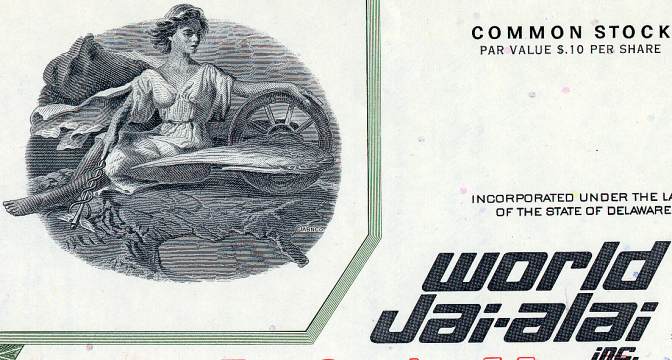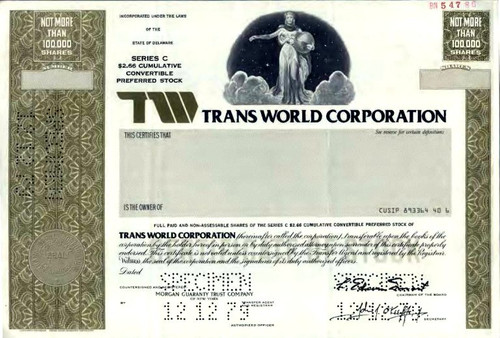Beautifully engraved RARE certificate from the World Jai-alai printed in 1973. This historic document was printed by the American Banknote Company and has an ornate border around it with a vignette of a woman over the United States, and a player on the bottom left. This item has the printed signatures of the Company's President, and Secretary, and is over 38 years old. 
Certificate Vignette Jai alai (pronounced /ˈhaɪ.əlaɪ/ in English and [ˈxai aˈlai] in Basque) is a variety of Basque Pelota. The term is loosely often also applied to the fronton (the open-walled playing area) where the sport is played. It's called "Cesta punta" (the words for basket and tip) in Spanish. The Basque Government promotes jai alai as "the fastest sport in the world" because of the balls' speed (although Racquetball has actually seen faster speeds) and once held the record for world ball speed with a 125g140g ball covered with goatskin that traveled at 302 km/h (188 mph), performed by José Ramón Areitio at the Newport Jai Alai, Rhode Island, until it was broken by Canadian long drive champion Jason Zuback on an episode of Sport Science in July 2009 with a golf ball speed of 328 km/h (204 mph). The court (or cancha) for jai alai consists of 3 walls (front, back, and left), and the floor between them in play. If the ball (called a "pelota") touches the floor outside these walls, it is considered out of bounds. Similarly, there is also a border on the lower 3 ft (about 1 m) of the front wall that is also out of bounds. The ceiling on the court is usually very high, so the ball has a more predictable path. The court is divided by 14 parallel lines going horizontally across the court, with line 1 closest to the front wall and line 14 the back wall. In doubles, each team consists of a frontcourt player and a backcourt player. The game begins when the frontcourt player of the first team serves the ball to the second team. The winner of each point stays on the court to meet the next team in rotation. Losers go to the end of the line to await another turn on the court. The first team to score 7 points (or 9 in Superfecta games) wins. The next highest scores are awarded "place" (second) and "show" (third) positions, respectively. Playoffs decide tied scores. A jai alai game is played in round robin format, usually between eight teams of two players each or eight single players. The first team to score 7 or 9 points wins the game. Two of the eight teams are in the court for each point. The server on one team must bounce the ball behind the serving line, then with the cesta "basket" hurl it towards the front wall so it bounces from there to between lines 4 and 7 on the floor. The ball is then in play. The ball used in Jai Alai consists of metal strands tightly wound together and then wrapped in goat skin. Teams alternate catching the ball in their cesta and throwing it "in one fluid motion" without holding or juggling it. The ball must be caught either on the fly or after bouncing once on the floor. A team scores a point if an opposing player: fails to serve the ball directly to the front wall so that upon rebound it will bounce between lines No. 4 and 7. If it does not, it is an under or over serve and the other team will receive the point. fails to catch the ball on the fly or after one bounce holds or juggles the ball hurls the ball out of bounds interferes with a player attempting to catch and hurl the ball The team scoring a point remains in the court and the opposing team rotates off the court to the end of the list of opponents. Points usually double after the first round of play, once each team has played at least one point. The players frequently attempt a "chula" shot, where the ball is played off the front wall very high, then reaches the bottom of the back wall by the end of its arc. The bounce off the bottom of the back wall can be very low, and the ball is very difficult to return in this situation. Since there is no wall on the right side, all jai alai players must play right-handed (wear the cesta on their right hand). Jai alai arena in Mexico City near the Monument to the Revolution.In the United States, jai alai enjoyed some popularity as a gambling alternative to horse racing, greyhound racing, and harness racing, and remains popular in Florida, where the game is used as a basis for parimutuel gambling at five frontons throughout the state: Dania Beach, Orlando, Miami, Reddick (as "Ocala Poker and Jai Alai"), Fort Pierce, and Jasper (as "Hamilton Jai Alai and Poker"). The first jai alai fronton in the United States was located in St. Louis, Missouri, operating around the time of the 1904 World's Fair. The first fronton in Florida opened at the site of Hialeah Race Course near Miami (1924). The fronton was relocated to its present site in Miami near Miami International Airport. Year round jai alai operations include Miami Jai Alai (the biggest in the world with a record audience of 15,502 people in 27 December 1975) and Dania Jai Alai. Seasonal facilities are: Fort Pierce Jai Alai, Ocala Jai Alai and Hamilton Jai Alai. The Tampa Jai Alai operated for many years before closing in the late 1990s. Inactive jai alai permits are located in Tampa, Daytona Beach, West Palm Beach, and Quincy. One Florida fronton was converted from jai alai to greyhound racing in Melbourne. By contrast, jai alai's popularity in the north-eastern and western United States waned as other gambling options became available. Frontons in the Connecticut towns of Hartford and Milford permanently closed, while the fronton in Bridgeport was converted to a greyhound race track. A fronton in Newport, Rhode Island has been converted to a video lottery terminal facility. Jai alai enjoyed a brief and popular stint in Las Vegas, Nevada with the opening of a fronton at the MGM Grand Hotel and Casino; however, by the early 1980s the fronton was losing money and was closed by MGM Grand owner Kirk Kerkorian. The MGM Grand in Reno also showcased jai alai for a very short period (19781980). In an effort to prevent the closure of frontons in Florida, the Florida State Legislature passed HB 1059, a bill that changed the rules regarding the operation and wagering of poker in a Pari-Mutuel facility such as a jai alai fronton and a greyhound and horseracing track. The bill became law on August 6, 2003. The International Jai Alai Player Association-UAW Local 8868 is the recognized bargaining agent for jai alai players in most Florida frontons. The union had also represented jai alai players and fronton employees in Connecticut until its three frontons permanently closed, and in Rhode Island where at the behest of the gaming regulators, the Rhode Island Legislature abolished the playing of live jai alai in favor of video lottery terminals. It is a very popular sport within the Latin American countries, and the Philippine Islands due to its Hispanic influence, although it has been banned due to illegal gambling. However, jai alai was returned to the Philippines since March 2010. Although the sport is in decline in America, the first public amateur jai-alai facility was built in the United States in 2008, in St. Petersburg, Florida, with the assistance of the city of St. Petersburg. In addition to the amateur court in St. Petersburg, The American Jai-Alai Foundation whose president Victor Valcarce was a pelotari at Dania Jai-Alai (MAGO #86) and was considered the best "pelota de goma" player in the world, sponsors (in North Miami Beach, Florida) the only indoor air conditioned cancha, (once owned by World Jai-Alai as a school which in 1972 produced the greatest American pelotari "JOEY" #37) that is still open with free lessons from some of the sport's best. During the late 1960s, in addition to North Miami Amateur, there was at least one other amateur court, International Amateur Jai-Alai in South Miami. Many professional players emerged from South Miami Amateur, including "RANDY" #44 at World Jai-Alai, regarded as the first American pelotari, who turned pro in 1968 and enjoyed a lengthy career. Later in the late 1980s at least one other amateur court was constructed in Connecticut. Construction is currently underway on another amateur jai-alai fronton in Connecticut, which is tentatively slated for completion in the Spring of 2010 (http://www.ctamateurjaialai.com/). Interviews with Matt DiDomizio, owner/developer of CT Amateur Jai-Alai in Berlin, CT indicate that Churruca, one of the greatest players of all time, will throw out the first ball at the Grand Opening Ceremony. History from Wikipedia and OldCompany.com (old stock certificate research service)
About Specimen Certificates Specimen Certificates are actual certificates that have never been issued. They were usually kept by the printers in their permanent archives as their only example of a particular certificate. Sometimes you will see a hand stamp on the certificate that says "Do not remove from file". Specimens were also used to show prospective clients different types of certificate designs that were available. Specimen certificates are usually much scarcer than issued certificates. In fact, many times they are the only way to get a certificate for a particular company because the issued certificates were redeemed and destroyed. In a few instances, Specimen certificates were made for a company but were never used because a different design was chosen by the company. These certificates are normally stamped "Specimen" or they have small holes spelling the word specimen. Most of the time they don't have a serial number, or they have a serial number of 00000. This is an exciting sector of the hobby that has grown in popularity over the past several years.

Certificate Vignette
About Specimen Certificates Specimen Certificates are actual certificates that have never been issued. They were usually kept by the printers in their permanent archives as their only example of a particular certificate. Sometimes you will see a hand stamp on the certificate that says "Do not remove from file". Specimens were also used to show prospective clients different types of certificate designs that were available. Specimen certificates are usually much scarcer than issued certificates. In fact, many times they are the only way to get a certificate for a particular company because the issued certificates were redeemed and destroyed. In a few instances, Specimen certificates were made for a company but were never used because a different design was chosen by the company. These certificates are normally stamped "Specimen" or they have small holes spelling the word specimen. Most of the time they don't have a serial number, or they have a serial number of 00000. This is an exciting sector of the hobby that has grown in popularity over the past several years.














